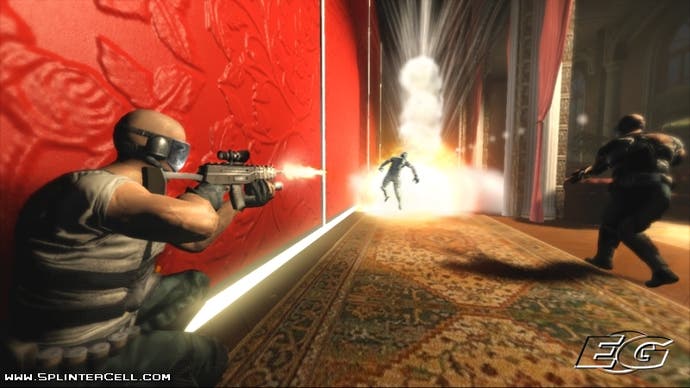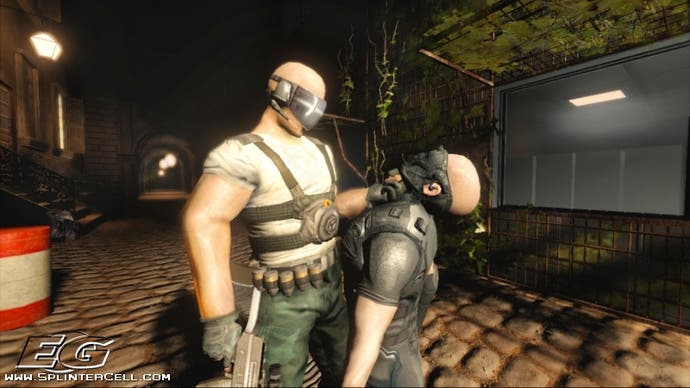Splinter Cell: Double Agent
Hands-on with the revamped multiplayer.
Splinter Cell might be best known for the stealthy acrobatics found in a trio of excellent single-player campaigns, but while the Sam Fishers of the world have been busy snapping necks, concealing bodies and throwing terrorists off lighthouses, Ubisoft has been busily experimenting with and refining one of the most innovative multiplayer components of any game to emerge in recent years.
Rather than simply bolting endless unimaginative deathmatch and capture-the-flag variants onto Splinter Cell's single-player maps, Ubisoft took the approach of focusing on both disciplines as separate entities - to the extent that entirely separate studios spread across several continents worked on the individual portions of the game. Beginning with Pandora Tomorrow, and refined with Chaos Theory, the two-on-two online component that resulted was entirely different from the single-player campaign, and full of superb ideas.
The concept of giving players the choice over whether to skulk in the shadows as spies, or wade in all-guns blazing as mercenaries was an excellent one, and extremely well-balanced. As a spy, you wandered the gloomy environments in familiar third-person perspective, able to utilise familiar gadgets and use your acrobatic capabilities to access areas off limits to your opponents. But at the same time, the spies lacked the powerful automatic weaponry or the close combat-favoured first-person view of the mercs. It was a tense, stressful, but ultimately hugely enjoyable component, and one that came into its own once you learned the maps and how to exploit the weaknesses of your opponents - and played it with clued-up team-mates who knew the drill.
The spy who loved meh

But - as with so many online multiplayer games - newcomers to the scene often found themselves frustrated and unable to make headway against their more skilled counterparts. Bogged down with swift deaths, and no easy way to scale the learning curve, Splinter Cell's multiplayer offering was a mite inaccessible to the newbie, essentially strangled by its most devout followers.
With the eagerly awaited Double Agent looming on the horizon, Splinter Cell: Double Agent multiplayer co-ordinator Thomas Leroux-Hugon took the opportunity to demonstrate the all-new expanded three-on-three multiplayer side of the game to us, and was quick to assure the fan base that it was keen to address past mistakes with a more rounded, more accessible version that will grow the popularity of Splinter Cell online to new heights.
"When we finished Chaos Theory, we used the server stats to see how people played the multiplayer game, and something big came up," Leroux-Hugon admits. "The fact that players that were used to it were playing it nearly every night with the same people.
"New players were kicked off within two or three days because it was too hard, and because they could not understand the gameplay," he argues. "They simply could not have any fun."
"So, our challenge [for Double Agent] was to keep the game fun, and make accessibility the main layer of the game."
Tense, nervous headaches...

The Ubisoft rep admits that while the single-player and multiplayer are very different, they both rely on the same 'emotional layer'. "The fun of Splinter Cell comes from the tension and the stress, and then the release of this tension that the players feels every time they play as a spy," he argues. Throw in the accessibility of a first-person shooter by giving players the chance to take down the spies as the big gun-wielding mercenaries and it's a good recipe. "Spies that move and are as acrobatic like Sam Fisher and mercenaries with big guns - this is the heart of the multiplayer and we wanted to keep it that way," he says.
"Even so, we had to work in a new game mode so that people would be able to understand in five or ten minutes how to play as a spy in third-person view, or as the mercenary like any FPS basically," he says, assuring fans that addressing the accessibility of multiplayer didn't mean dumbing down. "We didn't want to reduce things [but] it's important to make the game easy to 'get'."
Exactly as with previous Splinter Cell multiplayer modes, "the spy is in third-person view, he's got lots of moves, he can go anywhere, he can use a lot of technology and cool stuff, while the mercenaries are like raw hunters, they've got guns and grenades, have no [means of knowing] where the spy is, but are not that fragile. This is really the thing we work on, because we wanted to keep it and it's what we really cannot do without."
Demoing the Team Hack multiplayer game mode, we're shown (and later get a brief chance to play) a game of two phases. "The first phase is infiltrating the building, getting to the objective, trying to hack it - which is the core of the game - and the second is exflitration, which is just extracting the data and going back to the [spawn] point."
This way to happiness

Essentially, Ubi's at pains this time to leave the players of both sides in no doubt where they need to go, give them some basic - and obvious - visual cues such as ghost outlines that let the spies know which windows they can dive through, which equipment to hack and so on. At the same time, the way is clear to approach tasks from a variety of ways - and escape in a manner equally free yet intuitive. "We don't want the player to not understand what they can do, so we show you the best way to get to your objective, but it doesn't mean it's the only way. It means that you know what to do if you want to follow the rules, but you can also go everywhere and use new tactics and new ways at any time." It's not just idle PR puff either; it really does work well, making a previously stilted game (with controls well suited to single-player, but not the rough and tumble of urgent multiplayer matters) feel a more fluid affair, allowing spies to swiftly pull off actions in one slick motion.
The control tweaks extend to the gadgets too, with binds that allow one device to have a multitude of applications to remove the need to tediously access menu layers just to grab the one you need for the job. Given that they're "technical freaks" the spies have access to a hacking device that's not merely capable of hacking the cells that you have to hunt down, but also bypasses security devices and lets you scramble hunter drones, destroy windows and smash light fixtures. "By unifying all the systems we are able to use just one simple binding for all the base without making it an impossibility for the player," he promises. Nice work so far.
But those hoping for similar sweeping changes to the mercenaries will be disappointed. "The merc is the one we didn't touch - it's very easy to understand for newcomers. We made sure that new people that don't know the game can face very skilled spies are able to track them, to spot them and to kill them." But, as ever, the mercs will find themselves lacking the nimble climbing skills that enable the spies to slink into ventilation shafts and underfloor passageways - instead relying on their torchlight and new gadgets such as the self destructor drone that allows you send a remote device to those unreachable places that the spies hang out in. He admits "new players probably won't use them, but all the skilled players will want to access their gadgets to play their own way."
Splinter sell

The game's maps have changed a fair bit too. Not only have they been built from the ground up to take advantage of the next-gen tech, but they're bigger, more layered and evidently distinctly more detailed and, as such, dripping with the kind of gloomy atmosphere that's become the hallmark of Splinter Cell. But that's not all. "The main things we've added to the design is that we now have with four objectives, which means with four objectives there's always one objective less, which means you cannot send one man each to protect all of them by [camping]."
In addition, each side's HUD data is much more transparent to figure out, with "all the info you need always on the screen for you to share and use". Fellow team-mates' whereabouts and the position of the points you need to find or protect intuitively appear, and the fug of confusion that initially greeted newcomers is swiftly cleared with far better information on what to do and where to go.
As before, Ubisoft is ensuring plenty of other online modes make the cut. Key to the 360 offering, Ubisoft promises a persistent Team Ranking system makes the online challenges more meaningful. In Adversarial Mode players will "work their way up as an Echelon Spy or Upsilon Mercenary, improving your skills, inventory, and team ranking", with a companion Challenge Mode that allows players to play against bots to improve as a team.
With an ongoing recruitment system letting you hire the best agents from the online community, each with their own career statistics and choice of gear, Splinter Cell's online star looks set to rise dramatically. It's made even more interesting by the promise of 'spectacular escape moves' that we unfortunately didn't get to see during our rather limited hands-on.
Elsewhere, there's a PS2- and Xbox-specific Spy Vs. Spy mode, as well as Disk Hunt and Survival (exclusive to PS2), and a bunch of other modes that we're assured are in all versions including (deep breath) Deathmatch, Blitz, Key Run, Sam Vs All (Sam Fisher Vs three Upsilon spies), and Countdown (the more you kill the more you play). More detailed news when we get it.
With only a brief play-test and a swift presentation under our belt, it's still too early to judge whether Ubi's promises stack up, but the signs are definitely very good. Any attempt to broaden the appeal of the often cliquey, elitist world of online gaming has to be applauded, while the 360's team-based ranking/stats-based system is sure to go down a storm. We definitely consider ourselves suitably impressed so far.
Splinter Cell: Double Agent is due for release on Xbox 360, PS2, Xbox, PC and GameCube (and don't be at all shocked if PS3 gets added to that list n'all) in time for Christmas. Be sure to check back for all the latest developments on Sam Fisher's latest adventure, and check out the brand new game footage and screenshots elsewhere on the site.


